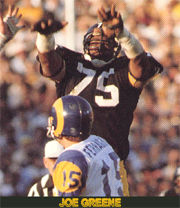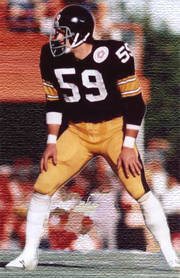

Jack Ham
TThe above images copied from football cards.
THOSE SAME OLD STEELERS
As the teams in Super Bowl IX lined up in the tunnel prior to the pre-game introductions, Joe Greene winked at Viking defensive tackle Alan Page and said, "You guys are in for a long afternoon." Greene was right. Minnesota never got an offense un- tracked.L. C. Greenwood, irritated at pre-game remarks by Ron Vary, made a revolving door of the all-pro tackle and spent the day with his hand seemingly growing from Viking quarterback Fran Tarkenton's face.
Greene dominated the line of scrimmage to the extent that Noll, who treats adjectives with the respect most people reserve for large denomination bills, said afterwards, "I never saw a defensive lineman play as well as Joe has this year."
The
Vikings, of course, were merely the beginning. A year later, the
Steelers lost only two of 14 regular-season games, a 30-21 decision to
Buffalo when
O. J. Simpson ran wild for 227 yards and a meaningless finale in Los Angeles.
The 74 draft had brought Lynn Swann and Jack Lambert and in their third seasons, they were possibly the dominant players at their positions. Jack Ham had blossomed into the finest outside linebacker in the game. The defense continued to shut down the run in every important game and Harris continued to get his 100-plus in every important game. A playoff tone had been established: Control the football, make them stop Harris. No one could and the Steelers rolled into Super Bowl X against Dallas.
An Ernie Holmes' hit put Baltimore quarterback Bert Jones out of action in the first playoff game and the Steelers dominated it; Lambert recovered three fumbles the following week against Oakland and the last one set up the deciding touchdown.
In Super Bowl X, more of the Noll philosophy prevailed. "Hang tough and wait for the good things to happen to you," he'd been telling them for years. Against the Cowboys, the Steelers did, Reggie Harrison sticking his upper lip in front of a Dallas punt with the Steelers trailing, 10-7, in the final quarter.
Following two Roy Gerela field goals, Bradshaw stood up under a safety blitz and threw a 64-yard touchdown strike to Swann to decide the issue and give Noll his second Super Bowl win and credibility to his coachly philosophies.
The Noll method was now obviously successful. One Super Bowl could've been a product of sheer talent and luck; a second obviously indicated coaching genius. It existed in the form of adhering unblinkingly to certain basics. The draft. Unhesitating discipline which ruled out favouritism.
Communication which demanded that all announcements affecting the team would first be made in team meetings. Noll's total control over football matters, to the degree that he chose hotels and menus on the road, selected even the smallest types of equipment, okayed, the hiring of anyone who conceivably could affect his players, passed on the club's public statements, and exercised the sort of overall authority which brought the unerring response to all decisions of, "Let's see what Chuck thinks about it."
The draft produced 43 of the 47 players on the first Super Bowl roster. It was the obvious foundation and when the Steelers went on to win their fourth Super Bowl championship, it was with an entirely home-grown roster. No single Steeler had ever received any sort of preferential treatment since Noll had fined Greene for walking into a training camp dormitory one minute past curfew. Eyeing a flat, white cardboard box in Greene's hands, Noll had smiled "I hope that pizza's good, Joe, it just cost you $25," and the message had never needed repeating.
Next Page - the last of six.